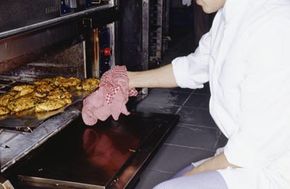The basic idea is "burn baby, burn!"
Self-cleaning ovens use an approximately 900 degrees Fahrenheit (482 degrees Celsius) temperature cycle to burn off spills leftover from baking, without the use of any chemicals. A self-cleaning oven is designed with a mechanical interlock (patented in 1982) to keep the oven door locked and closed during and soon after the high-temperature cleaning cycle, which can be approximately three hours. The door stays locked to prevent burn injuries. You can open the oven door after the oven cools to approximately 600 F (315 C).
Advertisement
If baking spills are not wiped up after baking, there may be some smoke during an oven cleaning cycle. It is a good idea to remove any pets from the area when running the oven's self-cleaning cycle. There have been reports of oven-heated Teflon-coated items releasing odorless fumes deadly to birds.
Self-cleaning ovens have the added benefit of more insulation, which helps the energy efficiency for regular baking. This is similar in concept to an increased R-factor for home insulation.
You will also save energy costs by using the self-cleaning cycle right after baking, to make use of the already partially heated oven.
Advertisement
